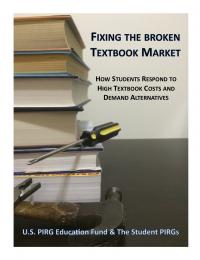
Many student governments have joined a growing movement to lower the cost of college textbooks.
At first, this might not seem like a profound issue, but for many students textbooks are the single largest out-of-pocket expense of going to college. The College Board estimates that students spend about $1200 on textbooks and supplies every year, and individual textbooks can cost as much as $200. Even worse, over the past decade, college textbook prices have increased by 82%, which is three times the rate of inflation.
Textbook prices can be a serious barrier for students and families struggling to afford a higher education – but they don’t need to cost so much. In the online age, we certainly have the technology to make textbooks more affordable.
U.S. PIRG published a recent report,
Fixing the Broken Textbook Market, that details the huge impact textbook prices have on students.
Among the findings:
- 65% of student consumers have opted out of buying a college textbook due to its high price. Of those students, 94% suffer academically.
- 48% of students said the price of textbooks determined which classes they take and how many classes they take.
Unfortunately, textbook publishing giants do everything they can to keep textbook prices high. They release new editions every few years (even in a subject like calculus, which hasn’t changed in a few hundred years…), keep prices at a premium, and package books with online codes and workbooks to undermine used book markets and rental programs.
Book rentals, used books, and e-textbooks have the potential to save students money in the short term, but they don’t solve the fundamental problem. The price of these alternatives is still determined by the cost that publishers set for new printed editions.
To end the burden of high textbook prices, we need to give students an alternative from
outside of the traditional market: open textbooks.
Open textbooks are faculty-written and peer-reviewed like traditional textbooks, but they are published under an open license, meaning they are free online, free to download, and affordable in print – usually $20-$40. Open textbooks have the potential to save students a tremendous amount of money – about $100 per student per course, on average.
To make open textbooks a real competitor to the traditional model, we need decision-makers at all levels – campus, state, and federal – to invest time and resources in promoting these books.
Driven by campaigns by student governments, PIRG chapters, and other groups, many schools are already making the leap: the University of Illinois, University of Minnesota, University of Maryland, Tacoma Community College, Rice University, Harvard, and MIT are just a few of the schools that have made a commitment to expanding the use of open textbooks on their campuses. The Association of Big 10 Students also recently endorsed open textbooks.
States are joining the movement as well. Washington state recently created its own Open Course Library and California has passed legislation to invest in open textbooks.
On campus, this movement is growing quickly. To show their support, students around the country are taking photos while holding signs that show how much they spent this year on textbooks and posting their pictures on social media. Student governments are passing resolutions and organizing the faculty and administrators on their campuses to join the effort.
Thank you to Ethan Senack, Higher Education Associate at U.S. PIRG, for providing information on this campaign. To get more information on this campaign, contact Ethan and follow the campaign hashtag on Twitter at #textbookbroke.
 Many student governments have joined a growing movement to lower the cost of college textbooks.
At first, this might not seem like a profound issue, but for many students textbooks are the single largest out-of-pocket expense of going to college. The College Board estimates that students spend about $1200 on textbooks and supplies every year, and individual textbooks can cost as much as $200. Even worse, over the past decade, college textbook prices have increased by 82%, which is three times the rate of inflation.
Textbook prices can be a serious barrier for students and families struggling to afford a higher education – but they don’t need to cost so much. In the online age, we certainly have the technology to make textbooks more affordable.
U.S. PIRG published a recent report, Fixing the Broken Textbook Market, that details the huge impact textbook prices have on students.
Among the findings:
Many student governments have joined a growing movement to lower the cost of college textbooks.
At first, this might not seem like a profound issue, but for many students textbooks are the single largest out-of-pocket expense of going to college. The College Board estimates that students spend about $1200 on textbooks and supplies every year, and individual textbooks can cost as much as $200. Even worse, over the past decade, college textbook prices have increased by 82%, which is three times the rate of inflation.
Textbook prices can be a serious barrier for students and families struggling to afford a higher education – but they don’t need to cost so much. In the online age, we certainly have the technology to make textbooks more affordable.
U.S. PIRG published a recent report, Fixing the Broken Textbook Market, that details the huge impact textbook prices have on students.
Among the findings:
